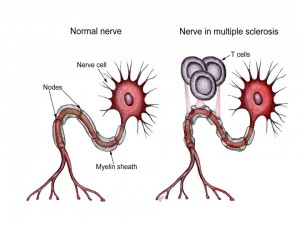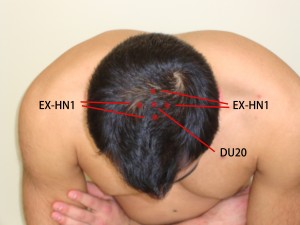News Letter, Vol. 4 (12), December , 2012, © Copyright
Jun Xu, M.D. Lic. Acup., Hong Su, C.M.D., Lic. Acup.
Robert Blizzard III, DPT
Rehabilitation Medicine and Acupuncture Center
1171 East Putnam Avenue, Building 1, 2nd Floor
Greenwich, CT 06878
Tel: (203) 637-7720
Fax: (203)637-2693
Multiple Sclerosis
americancompanioncare.com
Jane is a 40 year-old woman who complains of feeling tired and fatigue now for 6 months. She works as a computer programmer and has two children ages 4 and 6 years old. She never felt fatigue before, as she works 40 hours a week then comes home to take care of her family. She recently reports heat intolerance and a stumbling gait with a tendency to fall. Two months ago the patient was working very hard and was under a lot of stress. She then got sick with the flu and her neurologic condition worsened. Her visual acuity also seemed to change periodically during several years. She has had difficulty holding objects in her hands accompanied with significant tremors and severe exhaustion. She also had several bad falls. Since then, she had noticed multiple areas of joint pain on the right and subsequently on the left side of her body. Then, the patient abruptly developed a right side half body sensory deficit after several days of work.
She visited her Neurologist, who ordered a MRI scan which revealed a multifocal white matter in both cerebral hemispheres. Spinal tap was also done which showed the presence of oligoclonal bands in Cerebral Spinal Fluid. Visual evoked response testing was abnormal with slowed conduction in optic nerves.
This patient is most likely to have Multiple Sclerosis. This disease occurs more often in women between ages of 20-40. MS is caused by damage to the myelin in the central nervous system, and to the nerve fibers, which interferes with the transmission of nerve signals between the brain, spinal cord and other parts of the body. Depending on the location of the pathology, patients reveal the following symptoms.
Most Common Symptoms
Some symptoms of MS are much more common than others.
Fatigue
Numbness
Walking (Gait), Balance, & Coordination Problems
Bladder Dysfunction
Bowel Dysfunction
Vision Problems
Dizziness and Vertigo
Sexual Dysfunction
Pain
Cognitive Dysfunction
Emotional Changes
Depression
Spasticity
Less Common Symptoms
These symptoms also occur in MS, but much less frequently.
Speech Disorders
Swallowing Problems
Headache
Hearing Loss
Seizures
Tremor
Respiration / Breathing Problems
Itching
The Criteria for a Diagnosis of MS
In order to make a diagnosis of MS, the physician must:
- Find evidence of damage in at least two separate areas of the central nervous system (CNS), which includes the brain, spinal cord and optic nerves AND
- Find evidence that the damage occurred at least one month apart AND
- Rule out all other possible diagnoses
In 2001, the International Panel on the Diagnosis of Multiple Sclerosis updated the criteria to include specific guidelines for using magnetic resonance imaging (MRI), visual evoked potentials (VEP) and cerebrospinal fluid analysis to speed the diagnostic process. These tests can be used to look for a second area of damage in a person who has experienced only one attack (also called a relapse or an exacerbation) of MS-like symptoms — referred to as a clinically-isolated syndrome (CIS). A person with CIS may or may not go on to develop MS.
The criteria (now referred to as The Revised McDonald Criteria) were further revised in 2005 and again in 2010 to make the process even easier and more efficient. (http://onlinelibrary.wiley.com/doi/10.1002/ana.22366/full)
Treatment
There is no known cure for multiple sclerosis at this time. However, there are therapies that may slow the disease. The goal of treatment is to control symptoms and help you maintain a normal quality of life.
Medications used to slow the progression of multiple sclerosis are taken on a long-term basis, they include:
- Interferons (Avonex, Betaseron, or Rebif), glatiramer acetate (Copaxone), mitoxantrone (Novantrone), and natalizumab (Tysabri)
- Fingolimod (Gilenya )
- Methotrexate, azathioprine (Imuran), intravenous immunoglobulin (IVIg) and cyclophosphamide (Cytoxan) may also be used if the above drugs are not working well
Steroids may be used to decrease the severity of attacks.
Medications to control symptoms may include:
- Medicines to reduce muscle spasms such as Lioresal (Baclofen), tizanidine (Zanaflex), or a benzodiazepine
- Cholinergic medications to reduce urinary problems
- Antidepressants for mood or behavior symptoms
- Amantadine for fatigue
The following may also be helpful for people with MS:
- Physical therapy, speech therapy, occupational therapy, and support groups
- Assistive devices, such as wheelchairs, bed lifts, shower chairs, walkers, and wall bars
- A planned exercise program early in the course of the disorder
- A healthy lifestyle, with good nutrition and enough rest and relaxation
- Avoiding fatigue, stress, temperature extremes, and illness
- Changes in what you eat or drink if there are swallowing problems
- Making changes around the home to prevent falls
At some stage during the course of MS, over 75% of people report problems with balance. In addition to issues with balance is the prevalence of falls which is reported to be over 50%.
Evidence suggests that balance may be positively improved by:
Individual physiotherapy using facilitation and functional activities
Group exercise classes, primarily by way of a functional based framework
Home balance training interventions
Targeted force-platform balance tasks
(Balance for people with multiple sclerosis. ISBN: 978-0-9806637-2-3. MS Australia June 2009)
http://www.acefitness.org/certifiednewsarticle/687/designing-balance-exercise-programs-for-older/
It is critical to prevent overheating while exercising or performing daily activities as this will cause MS symptoms to become much worse. Taking numerous breaks with exercise, breaking daily chores down into smaller steps and avoiding hot and humid weather are a few steps to take. A cool water swimming pool is a great way to seek a fitness routine or finding a gym with air conditioner during the hotter months of the year. Again heat and humidity will cause nerve transmission to become slower and make symptoms intensify until body temperature returns and all of this can occur in just a half degree raise in body temperature.
Acupuncture treatment for MS:
Acupuncture can not cure MS, however, acupuncture treatment may significantly improve patient’s symptom, the following methods could be used to help MS patients.
- Common used points: Du20 Bai Hui, GB7 Qu Bing, GB8 Shuai Gu, UB9 Yu Zhen, Ht7 Shen Men, GB20 Feng Chi, UB15 Xin Shu, UB20 Pi Shu, UB18 Gan Shu, UB23 Shen Shu, UB32 Chi Liao, GB30 Huan Tiao, Sp6 San Yin Jiao, Lv3 Tai Cong, UB2 Zan Zhu, Kid3 Tia Xi.
- Fatigue and depression: Major points: St 36 Zu San Li, PC6 Nei Guan, LI4 He Gu, Ht7 Shen Meng, Sp6 San Yin Jiao, GB20 Feng Chi, Du20 Bai Hui, EX-HN1 Si Shen Cong, assistant points: Du14 Da zhui, Ren12 Zhong Wan, Ren14 Ju Que, Ren6 Qi Hai, Ren4 Guang Yuan, UB21 Wei Shu and UB23 Shen Shu.
- Weakness in the upper extremities: LI15 Jian Yu, LI11 Qu Chi, LI10 Shou San Li, SJ5 Wai Guan, LI4 He Gu
- Weakness in the lower extremities: GB30 Huan Tiao, St31 Bi Guan, GB31 Feng Shi, St36 Zu San Li, GB34 Yang Ling Quan, Sp6 San Yin Jiao, GB39 Xuan Zhong, UB60 Kun Lun.
- Speech difficulty: Ren23 Lian Quan, LI4 He Gu, Ht5 Tong Li, Du15 Ya Meng,
- Swallow difficulty: Ren22 Tian Tu, Ren23 Lian Quan, LI18 Hu Tu, GB20 Feng Chi, LI4 He Gu
- Bladder Dysfunction: Ren4 Guan Yuan, Ren6 Qi Hai, Ren3 Zhong Ji, UB23 Shen Shu
- Constipation: St36 Zu San Li, GB34 Yang Ling Quan, St25 Tian Shu, UB19 Da Chang Shu, Ren12 Zhong Wan
- Vision: UB1 Jing Ming, EX-HN5 Tai Yan, GB37 Guan Ming
- Facial Paralysis: SJ17 Yi Feng, St7 Xia Guan, St4 Di Chang, St6 Jia Che
Jane’s Treatment:
Jane’s main complaints are fatigue and weakness with visional difficulty. I choose the first and second groups of the points, plus Jing Ming, Tai Yan, Guang Ming. She received my treatment 3 x per week for 4 weeks, she felt her energy level was much better. She also was told not to be exposed to heat, because heat usually exacerbated fatigue and weakness. Her symptoms were getting better, she then kept her treatment once a week for maintenance. Her quality of life now is much improved.
Tips for Acupuncturists:
- St36 Zu San Li, Sp6 San Yin Jiao, LI4 He Gu and LI11 Qu Chi are most important points to improve energy and decrease fatigue for MS patients.
- Du20 Bai Hui and EX-HN1 Si sheng Cong can greatly decrease patients’ depression and improve energy.
Tips for Patients:
1, Massage Zu San Li 10 min x 2 to 3 per day will improve your energy level.
2. Avoid over heat, the more heat you exposed, the more fatigue and depression you will have.





